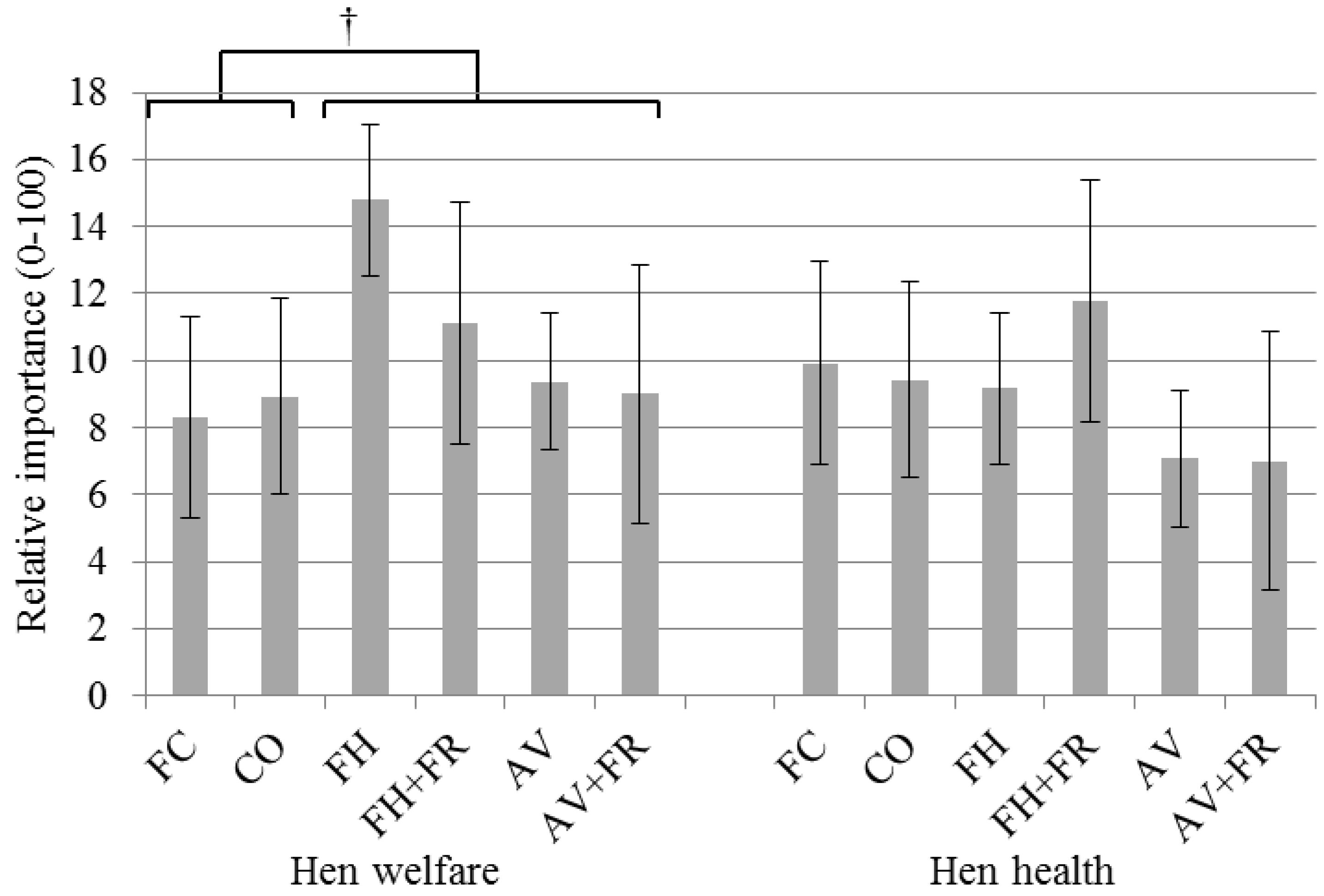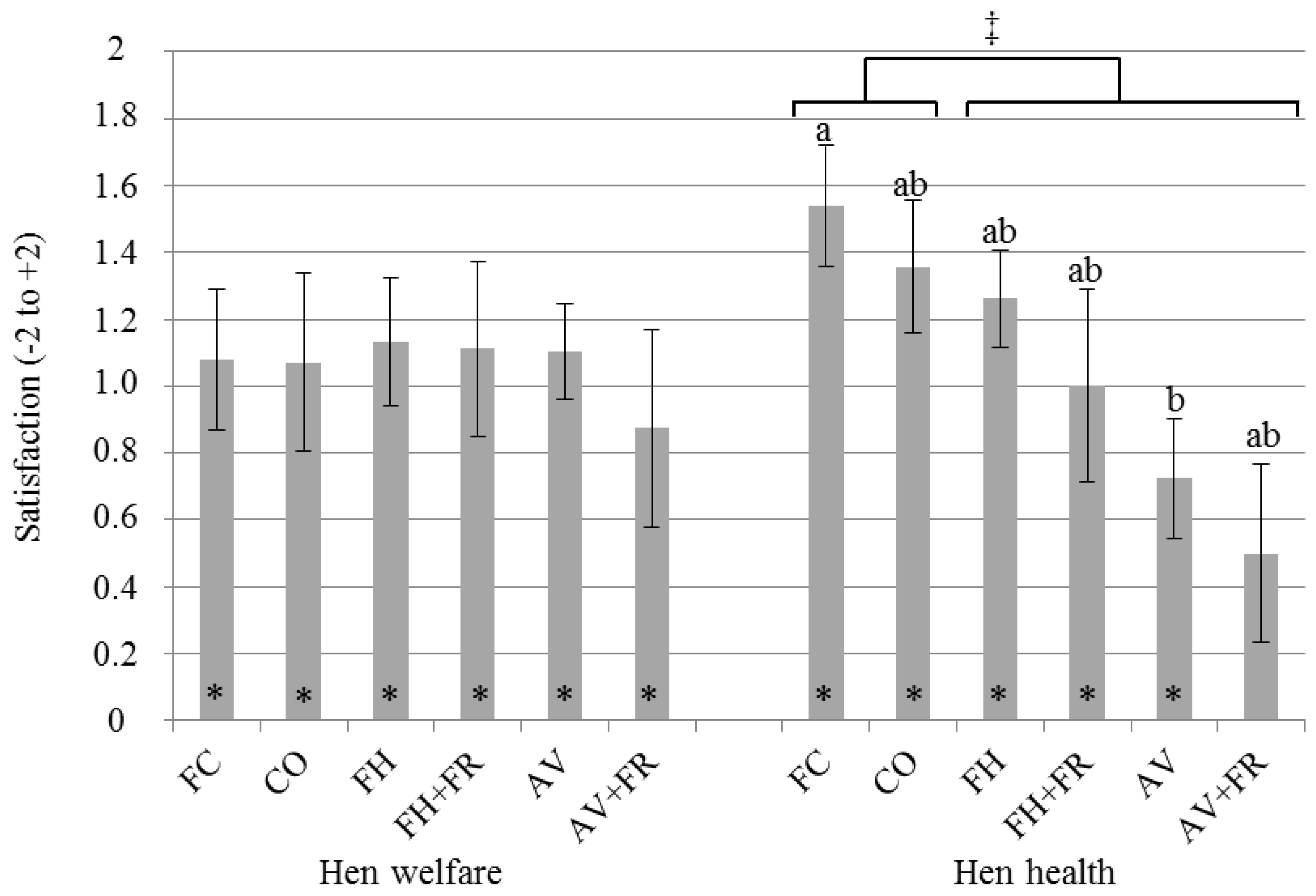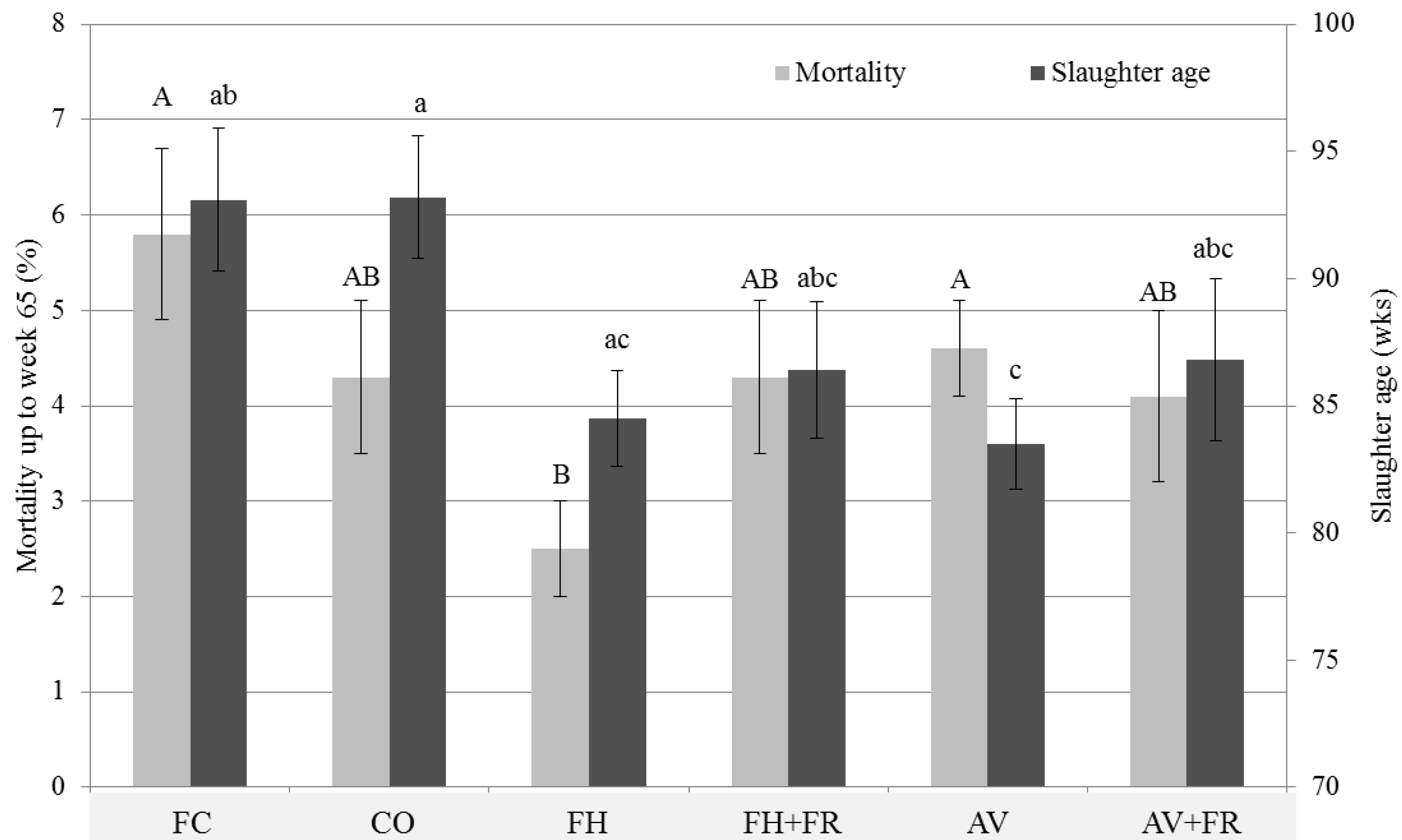Opinion of Belgian Egg Farmers on Hen Welfare and Its Relationship with Housing Type
Abstract
:Simple Summary
Abstract
1. Introduction
2. Experimental Section
| Principles | Criteria |
|---|---|
| Good Feeding | Absence of prolonged hunger |
| Absence of prolonged thirst | |
| Good Housing | Comfort around resting |
| Thermal comfort | |
| Ease of movement | |
| Good Health | Absence of injuries |
| Absence of disease | |
| Absence of pain induced by management procedures | |
| Appropriate Behavior | Expression of social behaviors |
| Expression of other behaviors | |
| Good human-animal relationship | |
| Positive emotional state |
3. Results
3.1. Importance of Hen Health and Welfare

3.2. Satisfaction with Hen Health and Welfare

3.3. Mortality and Slaughter Age

3.4. Occurrence of Welfare Problems

3.5. Importance of Welfare Parameters
| Welfare Parameter | Importance Score | |||||
|---|---|---|---|---|---|---|
| All Respondents (n = 81) | CC in Past (n = 47) | No CC in Past (n = 34) | ||||
| Welfare Quality® principles | ||||||
| Good feeding | 1.86 a | 1.77 ab | 1.94 a | |||
| Good health | 1.83 ab | 1.77 ab | 1.88 a | |||
| Good housing | 1.51 ab | 1.32 bcd | 1.74 ab | * | ||
| Appropriate behavior | 1.39 abc | 1.19 cde | 1.62 abcd | * | ||
| Welfare Quality® criteria | ||||||
| Absence of disease | 1.91 abc | 1.89 a | 1.884 a | |||
| Absence of injuries | 1.66 bc | 1.60 abc | 1.71 abc | |||
| Absence of prolonged thirst | 1.56 bcd | 1.55 abc | 1.53 abcde | |||
| Absence of prolonged hunger | 1.48 cd | 1.47 abcd | 1.44 abcdefg | |||
| Thermal comfort | 1.38 cd | 1.45 abcd | 1.24 bcdefgh | |||
| Comfort around resting | 1.35 cd | 1.23 cd | 1.47 abcdef | |||
| Ease of movement | 1.12 de | 1.02 def | 1.21 bcdefghi | |||
| Good human-animal relationship | 0.92 ef | 0.72 efg | 1.15 cdefghi | * | ||
| Positive emotional state | 0.78 ef | 0.62 fgh | 0.95 efghi | |||
| Absence of pain induced by management procedures | 0.77 efg | 0.72 efg | 0.79 hi | |||
| Expression of social behaviors | 0.75 efg | 0.64 fgh | 0.85 ghi | |||
| Expression of other behaviors | 0.58 efg | 0.49 gh | 0.65 i | |||
| Extra parameters | ||||||
| Expression of nesting behavior | 0.90 efg | 0.66 fgh | 1.18 bcdefghi | * | ||
| Presence of positive emotions | 0.78 fg | 0.53 fgh | 1.07 defghi | * | ||
| Absence of negative emotions | 0.61 fg | 0.36 gh | 0.92 fghi | * | ||
| Expression of foraging and dust bathing behavior | 0.50 g | 0.19 h | 0.88 ghi | * | ||
4. Discussion
5. Conclusions
Acknowledgments
Author Contributions
Conflicts of Interest
References
- Blokhuis, H.J.; van Niekerk Fiks, T.; Bessei, W.; Elson, A.; Guémené, D.; Kjaer, J.B.; Maria Levrino, G.A.; Nicol, C.J.; Tauson, R.; Weeks, C.A. The LayWel project: Welfare implications of changes in production systems for laying hens. World Poultry Sci. J. 2007, 1, 101–114. [Google Scholar] [CrossRef]
- Official Journal of the European Communities. EU Council Directive 1999/74/EC of 19 July 1999 laying down minimum standards for the protection of laying hens. 1999. Availabe online: http://eur-lex.europa.eu/LexUriServ/LexUriServ.do?uri=OJ:L:1999:203:0053:0057:EN:PDF (accessed on 19 November 2015).
- Van Horne, P.L.M.; Tacken, G.L.M.; Ellen, H.H.; van Niekerk Fiks, T.G.C.M.; Immink, V.M.; Bondt, N. Prohibition of Enriched Cages for Laying Hens in the Netherlands—An Exploration of the Consequences. Available online: http://www.rijksoverheid.nl/documenten-en-publicaties/rapporten/2007/09/07/verbod-op-verrijkte-kooien-voor-leghennen-in-nederland-een-verkenning-van-de-gevolgen.html (accessed on 19 November 2015).
- Cooper, J.J.; Appleby, M.C. The value of environmental resources to domestic hens: A comparison of the work-rate for food and for nests as a function of time. Anim. Welfare 2003, 1, 39–52. [Google Scholar]
- Olsson, I.A.S.; Keeling, L.J. The push-door for measuring motivation in hens: Laying hens are motivated to perch at night. Anim. Welfare 2002, 1, 11–19. [Google Scholar]
- Bubier, N.E. The behavioural priorities of laying hens: The effect of cost/no cost multi-choice tests on time budgets. Behav. Process. 1996, 2, 225–238. [Google Scholar] [CrossRef]
- Lindberg, A.C.; Nicol, C.J. Dustbathing in modified battery cages: Is sham dustbathing an adequate substitute? Appl. Anim. Behav. Sci. 1997, 1, 113–128. [Google Scholar] [CrossRef]
- Blokhuis, H.J.; Arkes, J.G. Some observations on the development of feather-pecking in poultry. Appl. Anim. Behav. Sci. 1984, 1, 145–157. [Google Scholar] [CrossRef]
- Huber-Eicher, B.; Wechsler, B. Feather pecking in domestic chicks: Its relation to dustbathing and foraging. Anim. Behav. 1997, 4, 757–768. [Google Scholar] [CrossRef]
- Savory, C.J. Laying hen welfare standards: A classic case of power to the people. Anim. Welfare 2004, 13, 153–158. [Google Scholar]
- Fossum, O.; Jansson, D.S.; Etterlin, P.E.; Vågsholm, I. Causes of mortality in laying hens in different housing systems in 2001 to 2004. Acta Vet. Scand. 2009. [Google Scholar] [CrossRef] [PubMed]
- Weitzenbürger, D.; Vits, A.; Hamann, H.; Distl, O. Effect of furnished small group housing systems and furnished cages on mortality and causes of death in two layer strains. Br. Poultry Sci. 2005, 5, 553–559. [Google Scholar] [CrossRef] [PubMed]
- Matthews, W.A.; Sumner, D.A. Effects of housing system on the costs of commercial egg production. Poultry Sci. 2014, 3, 552–557. [Google Scholar] [CrossRef] [PubMed]
- Aerni, V.; Brinkhof, M.W.G.; Wechsler, B.; Oester, H.; Fröhlich, E. Productivity and mortality of laying hens in aviaries: A systematic review. World Poultry Sci. J. 2005, 1, 130–142. [Google Scholar] [CrossRef]
- Singh, R.; Cheng, K.M.; Silversides, F.G. Production performance and egg quality of four strains of laying hens kept in conventional cages and floor pens. Poultry Sci. 2009, 2, 256–264. [Google Scholar] [CrossRef] [PubMed]
- Tuyttens, F.A.M.; Sonck, B.; Staes, M.; van Gansbeke, S.; van den Bogaert, T.; Ampe, B. Survey of egg producers on the introduction of alternative housing systems for laying hens in Flanders, Belgium. Poultry Sci. 2011, 4, 941–950. [Google Scholar] [CrossRef] [PubMed]
- Zeltner, E.; Klein, T.; Huber-Eicher, B. Is there social transmission of feather pecking in groups of laying hen chicks? Anim. Behav. 2000, 2, 211–216. [Google Scholar] [CrossRef] [PubMed]
- Nicol, C.J.; Gregory, N.G.; Knowles, T.G.; Parkman, I.D.; Wilkins, L.J. Differential effects of increased stocking density, mediated by increased flock size, on feather pecking and aggression in laying hens. Appl. Anim. Behav. Sci. 1999, 2, 137–152. [Google Scholar] [CrossRef]
- Lay, D.C.; Fulton, R.M.; Hester, P.Y.; Karcher, D.M.; Kjaer, J.B.; Mench, J.A.; Mullens, B.A.; Newberry, R.C.; Nicol, C.J.; O’Sullivan, N.P.; Porter, R.E. Hen welfare in different housing systems. Poultry Sci. 2011, 1, 278–294. [Google Scholar] [CrossRef] [PubMed]
- Bestman, M.W.P.; Wagenaar, J.P. Farm level factors associated with feather pecking in organic laying hens. Livest. Prod. Sci. 2003, 1–2, 133–140. [Google Scholar] [CrossRef]
- Nicol, C.J.; Pötzsch, C.; Lewis, K.; Green, L.E. Matched concurrent case-control study of risk factors for feather pecking in hens on free-range commercial farms in the UK. Br. Poultry Sci. 2003, 4, 515–523. [Google Scholar] [CrossRef] [PubMed]
- Heerkens, J.L.; Delezie, E.; Kempen, I.; Zoons, J.; Ampe, B.; Rodenburg, T.B.; Tuyttens, F.A.M. Specific characteristics of the aviary housing system affect plumage condition, mortality and production in laying hens. Poultry Sci. 2015, 9, 2008–2017. [Google Scholar] [CrossRef] [PubMed]
- Permin, A.; Bisgaard, M.; Frandsen, F.; Pearman, M.; Kold, J.; Nansen, P. Prevalence of gastrointestinal helminths in different poultry production systems. Br. Poultry Sci. 1999, 4, 439–443. [Google Scholar] [CrossRef] [PubMed]
- Höglund, J.; Jansson, D.S. Infection dynamics of Ascaridia galli in non-caged laying hens. Vet. Parasitol. 2011, 3, 267–273. [Google Scholar] [CrossRef] [PubMed]
- Jansson, D.S.; Nyman, A.; Vågsholm, I.; Christensson, D.; Göransson, M.; Fossum, O.; Höglund, J. Ascarid infections in laying hens kept in different housing systems. Avian. Pathol. 2010, 6, 525–532. [Google Scholar] [CrossRef] [PubMed]
- Stadig, L.M.; Ampe, B.A.; van Gansbeke, S.; van den Bogaert, T.; D’Haenens, E.; Heerkens, J.L.T.; Tuyttens, F.A.M. Survey of egg farmers regarding the ban on conventional cages in the EU and their opinion of alternative layer housing systems in Flanders, Belgium. Poultry Sci. 2015. [Google Scholar] [CrossRef] [PubMed]
- Welfare Quality® Welfare Quality® assessment for poultry (Broilers, laying hens). Welfare Quality® Consortium Lelystad, Nederland. 2009. Availabe online: http://www.welfarequality.net/network/45848/7/0/40 (accessed on 19 November 2015).
- Kauppinen, T.; Vainio, A.; Valros, A.; Rita, H.; Vesala, K.M. Improving animal welfare: Qualitative and quantitative methodology in the study of farmers’ attitudes. Anim. Welfare 2010, 4, 523–536. [Google Scholar]
- Te Velde, H.; Aarts, N.; van Woerkum, C. Dealing with ambivalence: Farmers’ and consumers’ perceptions of animal welfare in livestock breeding. J. Agric. Environ. Ethics 2002, 2, 203–219. [Google Scholar] [CrossRef]
- Vanhonacker, F.; Verbeke, W.; van Poucke, E.; Tuyttens, F.A.M. Do citizens and farmers interpret the concept of farm animal welfare differently? Livest. Sci. 2008, 1, 126–136. [Google Scholar]
- De Reu, K.; Rodenburg, T.B.; Grijspeerdt, K.; Messens, W.; Heyndrickx, M.; Tuyttens, F.A.M.; Sonck, B.; Zoons, J.; Herman, L. Bacteriological contamination, dirt, and cracks of eggshells in furnished cages and noncage systems for laying hens: An international on-farm comparison. Poultry Sci. 2009, 11, 2442–2448. [Google Scholar]
- Rakonjac, S.; Bogosavljević-Bošković, S.; Pavlovski, Z.; Škrbić, Z.; Dosković, V.; Petrović, M.D.; Petričević, V. Laying hen rearing systems: A review of major production results and egg quality traits. World Poultry Sci. J. 2014, 1, 93–104. [Google Scholar]
- Tauson, R. Management and housing systems for layers—Effects on welfare and production. World Poult. Sci. J. 2005, 61, 477–490. [Google Scholar] [CrossRef]
- Weeks, C.A.; Brown, S.N.; Richards, G.J.; Wilkins, L.J.; Knowles, T.G. Levels of mortality in hens by end of lay on farm and in transit to slaughter in Great Britain. Vet. Rec. 2012, 25, 647–647. [Google Scholar]
- Mollenhorst, H.; van Woudenbergh, C.J.; Bokkers, E.G.M.; de Boer, I.J.M. Risk factors for Salmonella enteritidis infections in laying hens. Poultry Sci. 2005, 8, 1308–1313. [Google Scholar] [CrossRef]
- Delezie, E.; Institute for Agricultural and Fisheries Research: Melle, Belgium. Personal communication, 2015.
- Abrahamsson, P.; Tauson, R. Performance and egg quality of laying hens in an aviary system. J. Appl. Poultry Res. 1998, 3, 225–232. [Google Scholar] [CrossRef]
- Abrahamsson, P.; Tauson, R. Aviary systems and conventional cages for laying hens: Effects on production, egg quality, health and bird location in three hybrids. Acta Agric. Scand. Sect. A-Anim. Sect. 1995, 3, 191–203. [Google Scholar] [CrossRef]
- Bilčík, B.; Keeling, L.J. Relationship between feather pecking and ground pecking in laying hens and the effect of group size. Appl. Anim. Behav. Sci. 2000, 1, 55–66. [Google Scholar] [CrossRef]
- Rodenburg, T.B.; Tuyttens, F.A.M.; de Reu, K.; Herman, L.; Zoons, J.; Sonck, B. Welfare assessment of laying hens in furnished cages and non-cage systems: An on-farm comparison. Anim. Welfare 2008, 4, 363–373. [Google Scholar]
- Allen, J.; Perry, G.C. Feather pecking and cannibalism in a caged layer flock. Br. Poultry Sci. 1975, 5, 441–451. [Google Scholar] [CrossRef] [PubMed]
- Cloutier, S.; Newberry, R.C.; Honda, K.; Alldredge, J.R. Cannibalistic behaviour spread by social learning. Anim. Behav. 2002, 6, 1153–1162. [Google Scholar] [CrossRef]
- Muir, W.M.; Cheng, H.W.; Croney, C. Methods to address poultry robustness and welfare issues through breeding and associated ethical considerations. Front. Genet. 2014. [Google Scholar] [CrossRef] [PubMed]
- Tuyttens, F.A.; Vanhonacker, F.; van Poucke, E.; Verbeke, W. Quantitative verification of the correspondence between the Welfare Quality® operational definition of farm animal welfare and the opinion of Flemish farmers, citizens and vegetarians. Livest Sci. 2010, 1, 108–114. [Google Scholar] [CrossRef]
- Tuyttens, F.; Vanhonacker, F.; Verbeke, W. Broiler production in Flanders, Belgium: Current situation and producers’ opinions about animal welfare. World Poultry Sci. J. 2014, 2, 343–354. [Google Scholar] [CrossRef]
- Bock, B.B.; van Huik, M.M. Animal welfare: The attitudes and behaviour of European pig farmers. Br. Food J. 2007, 11, 931–944. [Google Scholar]
- Lund, V.; Hemlin, S.; White, J. Natural Behavior, Animal Rights, or Making Money—A study of Swedish organic farmers’ view of animal issues. J. Agric. Environ. Ethics 2004, 2, 157–179. [Google Scholar] [CrossRef]
© 2015 by the authors; licensee MDPI, Basel, Switzerland. This article is an open access article distributed under the terms and conditions of the Creative Commons by Attribution (CC-BY) license (http://creativecommons.org/licenses/by/4.0/).
Share and Cite
Stadig, L.M.; Ampe, B.A.; Van Gansbeke, S.; Van den Bogaert, T.; D’Haenens, E.; Heerkens, J.L.T.; Tuyttens, F.A.M. Opinion of Belgian Egg Farmers on Hen Welfare and Its Relationship with Housing Type. Animals 2016, 6, 1. https://doi.org/10.3390/ani6010001
Stadig LM, Ampe BA, Van Gansbeke S, Van den Bogaert T, D’Haenens E, Heerkens JLT, Tuyttens FAM. Opinion of Belgian Egg Farmers on Hen Welfare and Its Relationship with Housing Type. Animals. 2016; 6(1):1. https://doi.org/10.3390/ani6010001
Chicago/Turabian StyleStadig, Lisanne M., Bart A. Ampe, Suzy Van Gansbeke, Tom Van den Bogaert, Evelien D’Haenens, Jasper L.T. Heerkens, and Frank A.M. Tuyttens. 2016. "Opinion of Belgian Egg Farmers on Hen Welfare and Its Relationship with Housing Type" Animals 6, no. 1: 1. https://doi.org/10.3390/ani6010001






